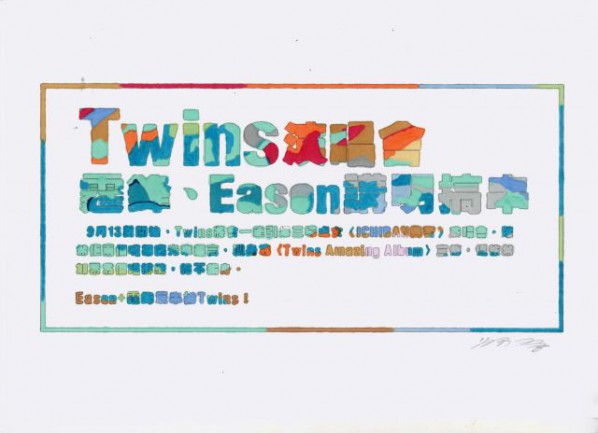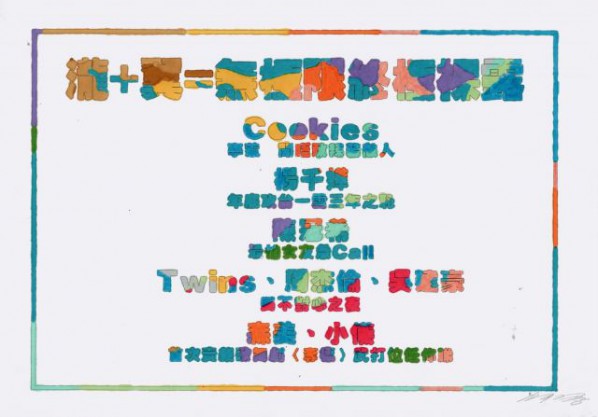
Tang Contemporary Art is delighted to present Zheng Guogu’s solo exhibition “Images of Magnetic Resonance” on 12th July 2014, Beijing, 798 Art District.
Zheng Guogu was born in 1970, Yangjiang, China, and currently lives and works in Yangjiang. Zheng Guogu uses different media and materials to experiment and his work spans across performance, photography, painting, sculpture, embroidery, and land art. He frequently uses heterogeneous elements to create hybrids, resulting in the creation of critically ambiguous art forms.
In the 90s, the influence of Hong Kong pop culture permeated, without exception, throughout Yangjiang and all across China. Zheng Guogu focuses on the effects of mass media and how the representation of life can be constructed in modern life and culture. Through a series of experimental works ranging from ‘My Bride’ to ‘Honeymoon’ and his return to Yangjiang’s delinquent youth in ‘Aberrant Conduct’, the artist becomes something akin to a director. His work is situated in-between fiction and reality, using photography and performance to document the processes of transformation occurring in culture and tradition in contemporary society.

Zheng Guogu, Miscellaneous Series Yuan Jue

Zheng Guogu, Miscellaneous Series, WenShuShiLi
Beginning with the piles of photographs in ‘Ten Thousand Customers’, the artist has entered a new phase of work that explores an artwork’s capacity to scrutinize the explosion of information initiated by the digital age. The boundaries of his work slowly become blurred: for example methods of using calligraphy paper, oil painting, and embroidery are gradually cobbled-and-matched together. Zheng Guogu seemingly takes unrelated forms (computers, calligraphy paper, or photographs) and mixes them together. He begins with the canvas or “sampling” images gleaned from media surfaces of the entire country (particularly magazines from Hong Kong pop culture). From different kinds of gossip news, slogans from commercials, and media sound-bites, to the popular topic sections, he created ‘Pig’s brain contrals Human’s brain’, as well as series of work such as ‘Sewing For Another Two Thousand Years’ – they each collapse the ‘authority’ of traditional multi-media in amusing ways.
From photographs that mimic life to how design can remodel ways of living, Zheng Guogu takes his inspiration from the online game ‘Age of Empires’: constructing in material dimensions a garden and buildings in Yangjiang, which are designed as unique spaces functioning as art studios and exhibition halls. After experiencing the last ten years of ‘expansion’, in the last year the name ‘Age of Empires’ has been changed to ‘The Park’, in continuation of his task to complete this unfinished work. In his words, all kinds of things can become art and art can become all kinds of things too.

Zheng Guogu, No. 248

Zheng Guogu, No. 262
For ‘Images of Magnetic Resonance’, the current Zheng Guogu solo exhibition at Tang Contemporary Art, Zheng Guogu explores in diverse ways the different dimensions of life: he believes that the production of human consciousness first enters through the perceptual area of the right brain, then through the analysis and process of the cerebellum, and then out of the rational area of the left brain. Notions of time and space become intertwined with a one-sided form of consciousness - according to their innate abilities, people can use this to their advantage only through their responses. This art practice intricately uses methods to connect an exploration of space, body, and the spirit.
Zheng Guogu has divided the exhibition hall into four parts: a large installation occupies the big exhibition hall ‘Spiritual Tour of a Pure Garden’, transforming expressions from common culture into rock sculptures. These are then spread around the white exhibition hall to become a ‘garden of text’ - a setting for worshippers to enjoy the vista and as a seating area. In the other smaller exhibition hall is a continuation of the artist’s series ‘Pig’s brain contrals Human’s brain’, where the whole wall will be covered by common character scripts small and large. In another area, the artist creates work following magnetic field theory “Cranial Nerve Diagram”, the artist follows the Bodhisattvas used to attain enlightenment to abstract and transform them into diagrams of cranial nerves with the belief that they can bring about a miraculous spiritual layer resonating with its magnetic field.
In the last exhibition hall, there are blank canvases for four painters facing one another. At the exhibition opening, the artist will be on the sidelines listening in for information. The information will then be processed through the electronic signals of his brain, to be conveyed to the four painters, who will proceed to capture pictures connected to the reality of the space’s magnetic field.
This newly created art attempts to open up the multi-dimensionality of space and living. It is also proceeds through different processes, thereby mapping out today’s relationship between the individual and it’s surrounding, which is related to the transformative connections related to a “fantasy, which also becomes reality”. In other words, how do we become free from restraints or to see through this era’s guise and fantasies; this particular issue has always been a crucial line of questioning within his practice.
Zheng Guogu adopts the kind of illusionary inducing strategies used by real media companies in an attempt to develop an autonomous language; a language resistant to the ‘lingua franca’ of the authorial structures, which have assimilated artistic trends up to this day.
About the exhibition
Duration: Jul 12, 2014 - Aug 24, 2014
Opening: Jul 12, 2014, 16:00, Saturday
Venue: Tang Contemporary Art Beijing
Courtesy of the artist and Tang Contemporary Art Beijing, for further information please visit www.tangcontemporary.com.




























